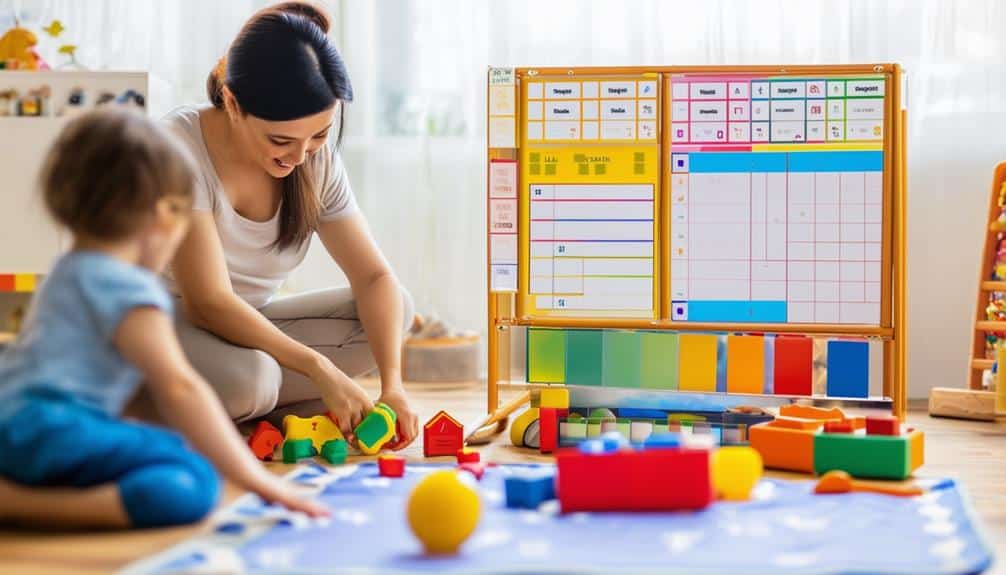Key Takeaways
- Establish clear boundaries and consistently implement consequences to manage challenging behaviors.
- Use positive reinforcement to encourage and motivate desired behavior.
- Apply redirection and distraction techniques to shift focus away from harmful behavior.
- Foster open and honest communication to understand better and address behavioral triggers.
Understanding Challenging Behaviors
Understanding challenging behaviors is vital to effectively navigating a child’s childhood through early education. These behaviors often manifest as tantrums, defiance, and other disruptive actions that can significantly impede learning and interpersonal interactions. While common in young children, these behaviors can hurt their overall development and success if not adequately addressed.
Notably, challenging behaviors such as fussiness, anger, physical harm, and disruption are not just disruptions but signals for unmet needs or skills yet to be developed. By empathetically viewing these behaviors through the lens of the ABC formula, which stands for antecedent (what happened before), behavior (what the child did), and consequence (what happened after), it becomes possible to identify the causes and triggers.
Addressing challenging behaviors is crucial for helping children succeed with future issues. This process involves understanding the behavior, its triggers, and the child’s developmental stage.
Focusing on understanding challenging behaviors guarantees a conducive learning environment and a child’s growth. It is a critical step towards nurturing resilient, empathetic, and mentally healthy individuals.
Strategies for Addressing Behaviors
Addressing challenging behaviors in children can seem intimidating, but it can be managed strategically.
Clear consequences, positive reinforcement, and redirection techniques can help shape these behaviors into more acceptable patterns.
This discussion will outline these strategies and provide insight into how they can empower the child and foster a conducive environment for their development.
Implementing Clear Consequences
Implementing explicit and consistent outcomes can often provide a structured environment that supports behavior management and learning when managing challenging behaviors in young children. Clear outcomes serve as a guide, helping children recognize inappropriate behaviors and teaching them the importance of positive behavioral shifts.
Understanding the connection between actions and outcomes is essential for young children to develop self-regulation skills and accountability. This understanding forms a fundamental part of their cognitive development and will govern their decision-making processes in the future.
When implemented, consistent outcomes promote a sense of fairness and predictability. Children realize that rules are applied evenly, regardless of situation or person. This teaches them about justice and helps create a secure environment where expectations are clear and the consequences of not meeting them are known.
In essence, clear outcomes are an integral part of effective behavior management. Through this strategy, we can guide young children towards better behaviors, instill in them the values of accountability and fairness, and set them on a path of responsible decision-making.
Positive Reinforcement Use
Research indicates that positive reinforcement is more effective in behavior modification than punishment. It offers children a clear understanding of their expected behaviors, fostering a sense of accountability and self-awareness. Consistent utilization of this method can result in enduring behavior changes.
Focusing on positive rather than negative behavior motivates children to perpetuate those behaviors. To illustrate, consider the table below:
| Action | Positive Reinforcement | Result |
|---|---|---|
| The child cleans up toys without being asked | Praise the child for their initiative | The child is likely to repeat the behavior |
| The child shares a toy with a sibling | Reward the child with a privilege | Sharing behavior is encouraged |
| The child completes homework on time | Give the child a small reward | On-time homework submission becomes a habit |
Redirection and Distraction Techniques
Redirection and distraction techniques effectively manage challenging behaviors in young children. The child goes from unsuitable behavior to a more appropriate activity or task. These methods are not merely vital but proactive approaches that mitigate the escalation of disruptive behaviors while promoting positive ones.
Redirection involves redirecting the child away from unwanted behavior and toward constructive activity. This might include introducing a new task or suggesting a different toy use. It is not punitive but supportive and nurtures the child’s sense of self-regulation and management capacity.
Distraction is a temporary intervention that redirects a child from a challenging behavior. Tools for distraction could include toys, books, or puzzles. Consistent use of these distraction tools can effectively curb challenging behaviors.
Understanding and practicing redirection and distraction techniques is essential in fostering a nurturing environment. When applied consistently and empathetically, these methods can help children self-regulate and manage their feelings more effectively, equipping them with lifelong resilience and adaptability skills.
The Role of Prevention Practices

The role of prevention practices in managing challenging behavior in young children cannot be underestimated.
Establishing clear expectations and fostering positive relationships can help children better understand their boundaries and feel supported in maneuvering their behaviors.
These preventative measures provide structure and predictability and encourage mental regulation and social skills development, which are critical factors in behavior management.
Establishing Clear Expectations
Utilizing prevention practices, particularly establishing clear expectations, can play a pivotal role in managing and preventing challenging behavior in young children. When children understand what is anticipated, they are more likely to behave inconsistently with those expectations.
Creating a structured and predictable environment can also help reduce anxiety and children of security. These settings provide stability, allowing children to focus on their activities without fearing unexpected disruptions.
Regularly teaching and practicing social skills can help children interact positively with others. This gives them the tools to express their feelings and thoughts respectfully and effectively.
We also emphasize the importance of encouraging regulation strategies for feelings. These empower children to manage their emotions effectively, fostering a sense of self-control and resilience.
Below is a table summarizing these key strategies:
| Prevention Practice | Benefits | Examples |
|---|---|---|
| Establish clear expectations | Promotes consistency | Setting clear rules |
| Create structured environments | Reduces anxiety | Predictable routines |
| Teach social skills | Improves interactions | Role-playing |
| Encourage regulation of feelings | Fosters self-control | Breathing exercises |
Fostering Positive Relationships
Fostering positive relationships, an essential aspect of prevention practices, provides a nurturing and supportive environment that significantly enhances a child’s mental health. It builds trust and security and encourages the growth of positive behavior.
It’s critical to understand that these relationships are not built overnight. They require consistent effort and understanding. For instance, implementing clear expectations and rules provides a sense of predictability. This structure helps them feel safe and understood, promoting positive behaviors in challenging situations.
The role of social skills should also not be overlooked. Regularly teaching and practicing these skills can enhance a child’s ability to communicate and solve problems effectively. This boosts their self-esteem and empowers them to handle challenging behaviors.
Similarly, strategies for regulating emotions are pivotal. Encouraging these strategies can help children manage stress and anxiety effectively, fostering resilience and emotional well-being.
Teaching Vital Social Skills
Teaching essential social skills is pivotal in enhancing children’s communication and problem-solving abilities in early childhood education. It’s a proactive strategy to prevent challenging behavior and promote positive interactions. Educators and caregivers can effectively reduce conflicts and misunderstandings by fostering these social and heartfelt skills, creating a more harmonious learning environment.
For instance, teaching children to understand others can foster empathy and prevent conflicts. It also boosts self-confidence and self-esteem among children, equipping them to navigate the world with a greater sense of self-worth and respect for others.
Moreover, improved social skills can lead to better relationships with peers and adults. Children who can communicate effectively and solve problems amicably are often more liked and respected by their peers. This social acceptance, in turn, can markedly influence their overall happiness and well-being.
Building Emotional Competencies

Building psychological competencies in young children is a significant aspect of early education that effectively manages well-being. This process enhances self-awareness and self-regulation and bolsters resilience, promoting better mental intelligence and overall well-being.
Understanding the importance of psychological competencies can be transformative for caregivers grappling with challenging behavior in young children. Encouraging these competencies fosters improved well-being skills and mental health, encouraging children to navigate uncomfortable feelings and stressors in a healthier, more productive manner.
Building psychological competencies also helps children understand and regulate their emotions. This skill is paramount as it allows children to identify their feelings, understand why they occur, and determine how best to respond. This knowledge equips children with the tools necessary to control their emotions rather than being controlled by them.
Collaborative Behavior Support
Collaborative Behavior Support underscores the importance of a united effort to manage challenging behaviors in young children.
This involves fostering open communication between parents and teachers and implementing consistent support strategies across different settings.
The role of professionals, such as psychologists or therapists, is also essential in crafting a thorough and effective behavior management plan.
Parent-Teacher Communication
Addressing and supporting challenging behaviors in young children requires regular communication between parents and teachers, which forms a cornerstone of effective collaborative behavior management. To add a child, both parties must share relevant information about the child’s child’s concerns and progress.
Developing a more collaborative approach to behavior management can be achieved through:
- Sharing Details: Regular updates on a child, both positive and negative, can bridge the gap between home and school settings. This shared understanding allows for a more thorough approach to behavior support.
- Collaborative Behavior Support Plans: Parents and teachers should work together to develop personalized behavior support plans. This teamwork ensures that strategies are consistent and tailored to meet the child’s needs.
Consistent Support Strategies
Consistent support strategies, or collaborative behavior assistance, are pivotal in addressing challenging behaviors in young children. They leverage the collective efforts of educators, parents, and professionals. This multifaceted approach guarantees a unified commitment to dealing with child behavior across various settings, at home, in school, or the community.
Collaborative behavior assistance thrives on regular communication and information sharing among the stakeholders. The key lies in understanding that every child is distinct, and a consistent, tailored strategy can effectively address their specific needs. This approach, however, is not about enforcing strict rules but about creating a supportive environment that nurtures a child’s success.
It is equally important to maintain an empathetic approach while implementing these strategies. The goal is not just to manage the behavior but to understand its root cause, facilitating better responses in the future. This well-being is time-consuming and requires patience, but the long-term benefits for the child are invaluable.
Ultimately, a collaborative behavior assistance system aims to empower the child and foster resilience, self-control, and positive social interactions.
Professional Involvement Necessity
The necessity of expert involvement in collaborative behavior support cannot be overstated. Experts bring a wealth of knowledge and expertise to crafting effective strategies for handling challenging behaviors in young children. Acknowledging this necessity is the first step towards creating an effective support system for children exhibiting challenging behaviors.
Expert involvement facilitates the development of thorough strategies. Mental health professionals provide valuable insights into children, ensuring the approach is tailored to each child’s
Professionals foster collaboration among all parties involved in the child’s development. They work hand-in-hand with educators, support staff, and families, ensuring a consistent approach to behavior support across different settings.
Professionals can adjust the strategies or suggest more specialized assistance if challenging behaviors persist despite initial interventions.
Incorporating these three essential elements into the collaborative support system creates a holistic approach to addressing challenging behaviors. We must remember that our shared goal is the well-being of the child. By leveraging expert involvement, we can guarantee that the children meet effectively and compassionately, ultimately leading to their successful development and growth.
Family Involvement in Behavior Management

Understanding families’ well-being in a child’s changing behavior can significantly improve the effectiveness of behavioral support, leading to a more comprehensive and consistent approach. Collaboration between caregivers and families is crucial, enabling the sharing of valuable insights and information about the child. This teamwork helps create a unified behavior plan tailored to the child’s needs.
Such a plan, co-created by families and caregivers, fosters a sense of partnership and shared responsibility. It champions the understanding that managing challenging behaviors is not an isolated task but a collective effort. This involves regular and open communication about behavior concerns, promoting a supportive and cohesive approach to behavior management.
Involving families in this process is not just about sharing the burden; it is about empowering them. It is about acknowledging their integral role in a child’s development and lending them the tools and knowledge to contribute meaningfully to their behavioral management. This shared responsibility and partnership can lead to better outcomes for the child and cultivate an enriching environment for them to thrive.
Seeking Professional Help
Despite targeted interventions, managing the intricacies of persistent challenging behaviors may necessitate seeking professional assistance. Although this step is often overwhelming, it can be instrumental in creating a cheerful pathway for a child.
The decision to seek professional assistance usually arises when certain warning signs persist. These might include:
- Aggression towards others or self
- Withdrawal from social interactions
Such behaviors, when exhibited persistently, may indicate underlying mental health issues. Professionals like child psychologists, pediatricians, and psychiatrists can thoroughly evaluate a child’s cognitive and behavioral health.
Including the child in discussions about concerns and potential next steps is vital. Seek to collaborate with them to ensure they understand the importance of professional help and are comfortable with it.
The core goal of seeking professional assistance is collaborating with the mental health professional and the family to create a tailored plan. This plan should address the child’s singing behaviors in a supportive, understanding, and effective way.
The benefits of such intervention can be far-reaching, improving the child and the family’s quality of life.
Utilizing Additional Resources

Exploring a variety of resources can significantly enhance efforts to manage challenging behaviors in children effectively. Many available resources have been specifically designed to help caregivers, teachers, and well-being address challenging behaviors in young children. These resources are backed by years of research and offer practical strategies for promoting positive behavior and creating a nurturing environment.
For example, the CDC’s PCDC’s Parenting Tips provide insightful guidance on managing challenging behaviors effectively. The National Center for Pyramid Model Innovations is another invaluable resource that offers insights into teaching social-emotional skills at home. Three sThree’ sve Parenting resource web page is worth exploring for its practical strategies for promoting positive behavior.
The National Center on Child Health and Wellness also offers a resource, ‘Nurtur’ Them, NurtureNurture’f,’ that ‘supports addressing challenging behaviors. The Head Start Center for Inclusion also provides tips for promoting positive behavior and creating a nurturing environment.
Incorporating these resources into your approach strengthens your ability to use positive language and enhances your understanding of child behavior. Utilizing these additional resources is crucial in effectively managing challenging behaviors.
Encouraging Positive Behaviors
Fostering positive behaviors in young children is a multifaceted process involving a range of strategies, including using positive language, empathetic responses, and empowering choices. These strategies can significantly affect children in early childhood.
Positive language and reinforcement:
The language used when interacting with children matters greatly. Positive language, such as affirmations and encouragements, helps build a supportive environment that nurtures positive behavior. Reinforcement of good behavior also encourages the child to repeat such behaviors, promoting a positive reinforcement cycle.
Empathetic resIt’sresIt’sesesIt’sial to respond to challenging behavior with empathy rather than anger. This response helps children feel understood and valued, promoting positive behavior.
Empowering choices:
Allowing children to make choices can empower them and promote positive behavior. It is both a learning experience and an opportunity for children to feel in control, which can significantly decrease challenging behaviors.
Responding to challenging behavior in early childhood requires patience, understanding, and positive guidance. It’s not about managing behavior but about teaching children how to navigate their emotions and actions in a healthy, constructive way.
Setting Limits With Positivity

Setting limits with positivity is fundamental in nurturing positive behavior in children. It helps them comprehend expectations and consequences effectively. Using positive language to set these limits clarifies the expected behavior, fosters cooperation, reduces conflict and promotes a harmonious environment.
Positive language is a powerful tool for children of boundaries; instead of focusing on the negative aspect of what shouldn’t, emphasize the desired behavior. For instance, instead of ‘Don’t, ‘Don’t ‘u,” try “lea’e’Plea’e. This ‘phrasing subtly establishes the boundary while promoting positive action.
Moreover, reinforcing positive behavior when children follow set limits encourages them to make better choices in the future. Appreciating their adherence to these limits, expressed in a warm, affirmative tone, fortifies their understanding of the consequences of their actions.
Strengthening Social and Emotional Skills
Setting limits with positivity is vital to encouraging positive behavior, but developing social and psychological skills is just as crucial. These skills are fundamental to a child’s growth and impact their problem-solving abilities, communication skills, and emotional intelligence.
To successfully plan to address this aspect, consider these steps:
- Teach Social Skills: Provide opportunities for interaction and role-playing to help children learn appropriate social behavior. This aids in enhancing self-esteem and improving relationships with peers and adults.
- Develop Emotional Competencies: Encourage children to express their feelings and understand those of others. This will foster emotional intelligence and resilience, essential attributes in stress management.
As we continue collaborating on behavior, let’s consider the importance of strengthening social and psychological skills. These are essential tools in our efforts to nurture well-rounded, emotionally intelligent children who can face life’s lifelines with resilience and grace.
Frequently Asked Questions
How can handling challenging behavior affect a child’s development?
Handling challenging behavior with consistent strategies helps children learn self-regulation and positive social skills. Addressing these behaviors early can support a child’s growth and long-term success.
How Do You Respond and Overcome Challenging Behavior in Young Children?
Addressing challenging behavior in young children involves implementing consistent consequences, using positive reinforcement, redirecting attention, providing choices, and modeling appropriate behavior. This approach empowers the child while promoting positive behavioral change.
What Are the Five Steps to Help You Deal With Challenging Behaviour?
To address challenging behavior, first implement clear, consistent consequences. Second, use positive reinforcement. Third, redirect attention. Fourth, provide choices to empower decision-making. Eventually, model appropriate behavior, setting the stage for expected conduct.
How Do You Support a Child With Challenging Behaviour?
Supporting a child with challenging behavior involves clear, consistent boundaries, positive reinforcement for good behavior, and empowering choices. Modeling appropriate reactions and redirecting attention can also help manage and regulate behavior effectively.
What Are Some of the Strategies to Respond to Episodes of Challenging Behaviour?
Strategies for responding to challenging behavior include implementing consistent consequences, utilizing positive reinforcement, redirecting attention, offering choices, and modeling appropriate behavior. These methods promote understanding, cooperation, and positive behavioral change in young children.


Recent Comments